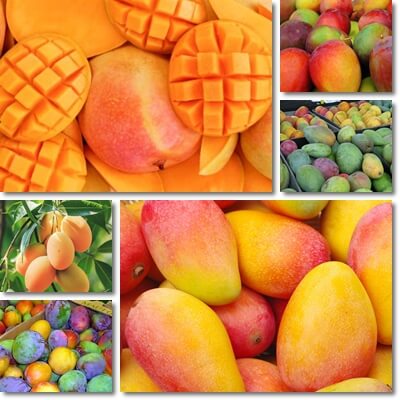The glycemic index, GI for short, is a scale that measures how fast the carbohydrates in a food raise blood sugar levels. Between 0-55 is a low GI. Between 56-69 is a moderate GI. Between 70-100 is a high GI. The lower the GI of a food, the lesser its effects on blood sugar. The higher the GI, the more pregnant the effects. Diabetics and anyone needing to manage their blood sugar are better off choosing lower glycemic foods as often as possible and avoiding high glycemic ones to the best of their efforts.
Mango on the glycemic index
Fresh mango glycemic index is 55, a low GI, bordering on moderate. This is the average GI value for the fruit. However, mango is not always a low-glycemic fruit. Some mangoes are higher on the glycemic index scale, 56 and upwards, up to about 60. It’s also possible for mango to be lower than 55 on the glycemic index (it can go as low as 40-50). It’s actually normal for the glycemic index score to vary by about 5-10 points, even for the same kinds of foods.

With fruits, it’s because of variations in nutritional profile. More exactly, carbohydrate profile. At their ripest, fruits reach their sugar potential and are fairly easily digestible. Less ripe or unripe ones have not yet broken down all of their carbs into sugar and are overall less easily digestible, hence their slightly lower GI. With some kinds of fruits, variety also matters. Some varieties are naturally higher in carbs and sugar, whereas others are lower. Even slight differences in carbohydrate content and profile account for variations of the glycemic index score. See more: Glycemic Index Fruit List
Frozen mango glycemic index
The glycemic index of frozen mango has not yet been determined. However, fresh and frozen fruits have about the same nutritional value. More exactly, the amount of carbohydrates and other macronutrients remains unchanged in the frozen fruit (up to a while, so does the micronutrient profile – vitamins, minerals).
Given that the carbohydrate profile is comparable between the fresh and frozen fruit, the glycemic index of frozen mango is presumed to be the same as that of fresh mango: an average GI score of 55, but which can go as low as 40-50 or a high as 60, depending on the fruit itself. Note: these values apply to the unsweetened fruit.
Dried mango glycemic index
The glycemic index of dried mango is undetermined at this point, but presumed to be moderate to high. Unsweetened, dried mango is presumed to be moderate GI. Sweetened, dried mango is presumed to be high-GI (69 and higher). When you dry a fruit, you essentially remove a certain amount of water from it.
By doing so, you also concentrate nutrients, especially carbohydrates (and sugar). And the more carbs a fruit has when it’s fresh, the more it’ll have when it’s dried. If the dried fruit is also sweetened, well, then it’ll be really high-carb.

If you have diabetes type 2 or 1 or are simply looking to manage your blood sugar, then know dried fruits are best eaten in a lot smaller quantities than their fresh counterparts and a lot less frequently.
Just as important, always choose unsweetened dried fruits, whether mango or other kinds. Read more advice on how to enjoy the fruit safely with diabetes type 2 and its benefits for the condition in the article Can You Eat Mango With Diabetes?
Mango on the glycemic load: 8 (for 100 g)
The glycemic load (GL) is a scale that measures how fast the carbohydrates in a serving of a food raise blood sugar levels. Below 10 is a low GL. Between 11-19 is a moderate GL. Over 20 is a high GL. The lower the GL of a food, the lesser its effects on blood sugar. Conversely, the higher the GL of a food, the greater its effects on blood sugar.
Fortunately, the smaller the serving of a food, the less carbohydrates you get to fuel the rise in blood sugar levels, so the lower its GL. Plenty of moderate and high GI fruits are low GL. In part, this is owed to the fact that the glycemic load is determined based on serving size and the number of carbohydrates you get in a serving of a food.
Assuming an average glycemic index of 55 (despite it not being applicable to all fruits of its kind):
– the glycemic load of fresh mango is 8, for a serving of 100 g with almost 15 g of carbs – low GL
– the glycemic load of a cup of mango pieces is 13.5-14 (165 g a cup, almost 25 g of carbs) – moderate GL
– the glycemic load of one mango fruit is 28 (336 g a fruit, 50.33 g of carbs) – high GL
How many carbs and how much sugar in mango?
100 g of the fresh fruit gets you almost 15 g of carbs of which 13.66 g are sugars and only 1.6 g dietary fiber. One cup of mango pieces at 165 g gets you almost 25 g of carbs of which 22.5 g are sugars and only 2.6 g dietary fiber. 100 g of dried, sweetened mango gets you about 78.6 g of carbohydrates of which 66.3 g are sugars and only 2.4 g dietary fiber.
Does eating mango raise blood sugar levels?
Mango has a lot of carbs, most of which are sugars. Naturally, eating it will raise blood sugar, diabetic or not. The important thing is to keep your intake reasonable and have small amounts of the fresh fruit at once, and avoid the dried options, whether sweetened or unsweetened.
To avoid your blood sugar going up too fast, you can have the fruit after a meal low in carbohydrates that also provides protein and some fat to help slow down sugar absorption. More important, consider your individual response to the fruit and adjust your intake accordingly.
Conclusion
So is mango low-glycemic? Mango is a low glycemic fruit with an average score of 55, bordering on moderate. In some instances however, it’s a moderate glycemic fruit, but not excessively higher on the GI scale (56 and slightly above). Despite this variation that occurs, as a diabetic, you can eat mango with your condition safely as long as you keep your intake reasonable. This is because the fruit has a low glycemic load score, when consumed in small amounts. Smaller portions of the fruit essentially get you less carbohydrates to fuel the rise in blood sugar levels, favoring blood sugar control.
